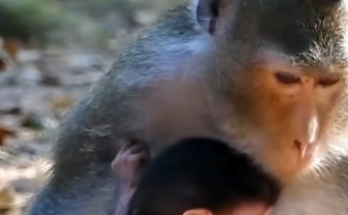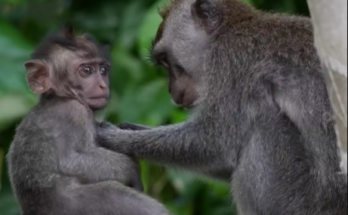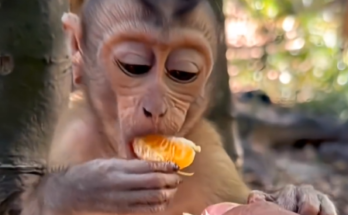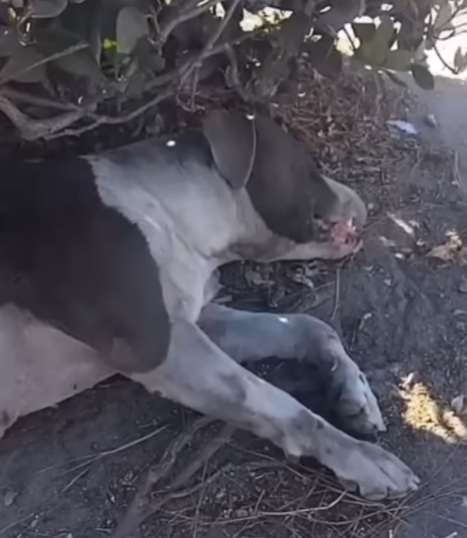
In a small, sleepy village nestled between misty hills, life usually moved slowly. Dogs roamed the streets freely, chickens clucked in the backyards, and the occasional traveler passed through, bringing the scent of distant cities and fresh bread. But one morning, the villagers’ quiet routine was shattered by the discovery of a small, trembling figure lying by the side of the road—a dog, barely more than a shadow of life, soaked in blood and mud.
She was tiny, with fur matted and dirty, and eyes that, despite the trauma she had suffered, still shone with a peculiar light. Some villagers gasped, some turned away, unable to bear the sight—but a young woman named Linh stepped forward without hesitation. Linh had always had a soft spot for animals, especially those who had been abandoned or hurt. She knelt beside the dog, speaking softly, her voice gentle and calm. “It’s okay… you’re safe now,” she whispered.
The dog’s injuries were severe. Her stomach bore a deep, cruel gash, the kind inflicted by a knife or a sharp metal object. A closer inspection revealed bruises and scrapes along her legs and sides, and Linh could see the deep fear etched into the dog’s expression. She had clearly been thrown from a moving vehicle, left to suffer on the side of the road. The villagers murmured in shock, horrified by the cruelty that someone could inflict on such a fragile creature.
Yet, even in her pain, the dog wagged her tail slightly, inching toward Linh as if understanding that this human meant no harm. Linh felt a lump in her throat. She scooped the dog into her arms and carried her home, gently wrapping her in a warm blanket. She named her Mai, after the spring flower that blooms even in harsh conditions—a symbol of resilience.
The journey to the veterinarian was urgent. Linh held Mai close in the car, murmuring comforting words, feeling the dog tremble against her chest. At the clinic, the vet immediately assessed the situation. “She’s been through a lot,” he said gravely. “The wound is serious, but if we act quickly, she can survive. She’ll need surgery and lots of care.”
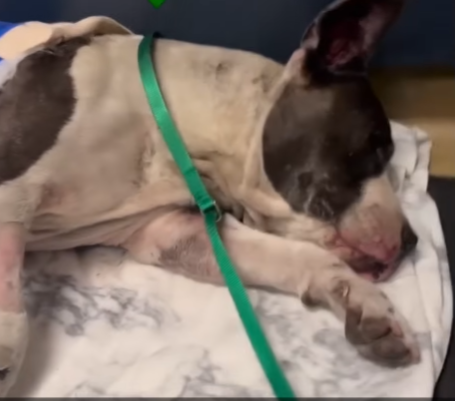
The surgery was long, delicate. The vet worked carefully to stitch her belly, stop internal bleeding, and remove fragments of debris that had lodged in the wound. Linh stayed by her side the entire time, refusing to leave, holding her paw and stroking her fur when she woke up, her eyes blinking drowsily, still trusting.
Recovery was slow. Mai had to stay in a special room with soft bedding, warm food, and plenty of water. She was weak, sometimes refusing to eat, trembling whenever she heard loud noises or the distant roar of cars. Yet Linh was patient, never forcing her, always letting her approach on her own terms. And slowly, over days and weeks, Mai began to regain strength.
What amazed everyone was her capacity for trust. After being thrown from a car, stabbed, and abandoned, most dogs would develop fear, aggression, or complete withdrawal from humans. But not Mai. She allowed Linh to handle her gently, leaned into her touch, and even nuzzled her cheek in gratitude. Her eyes held a quiet forgiveness, an understanding that humans could also be a source of safety, not just pain.
The villagers watched in awe as Mai transformed. She no longer trembled at the sound of passing vehicles, instead wagging her tail at anyone who approached her. She would follow Linh everywhere, even sitting patiently outside the local market as Linh ran errands. Children adored her, and she responded to their laughter and gentle strokes with soft whines and playful tail wags. She had survived a nightmare, yet she chose to embrace life with hope rather than fear.
One afternoon, as Linh sat in the garden trimming flowers, Mai suddenly ran to the fence, barking excitedly. A delivery man had arrived, and she approached him cautiously, sniffing, then wagging her tail. The man, unaware of her history, reached down to pet her, and she leaned into his hand, allowing a stranger to connect with her without hesitation. Linh smiled, tears prickling her eyes. “See?” she said softly. “You’re safe, and it’s okay to trust again.”
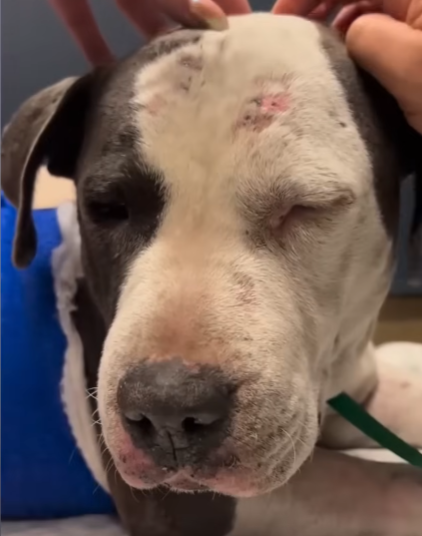
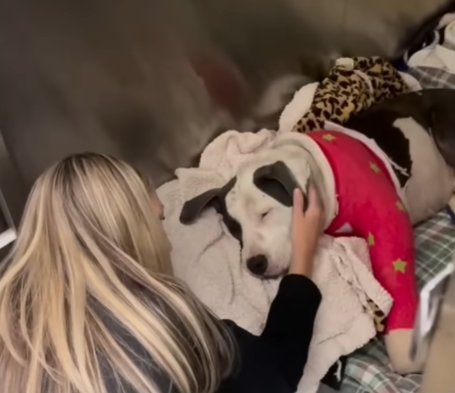
Mai’s story spread quickly through the village. People were inspired by her resilience and her ability to forgive. The local school even invited Linh to tell her story to children, teaching them about empathy, compassion, and the power of trust. Linh explained how Mai had suffered unimaginable cruelty yet had chosen to believe in the kindness of humans once more. “Trust isn’t given blindly,” Linh said. “It’s a choice, and sometimes, it takes a heart that’s been hurt to teach us how strong that choice can be.”
Months passed, and Mai flourished. Her coat grew shiny and soft again, her once-painful belly now healed and strong. She became the village’s unofficial ambassador for hope—a living reminder that cruelty doesn’t have to define a life, and that even in the darkest moments, trust and love can emerge.
People began to notice small, profound changes in their own lives as well. Inspired by Mai, several villagers who had once been indifferent to stray animals began feeding and caring for them. Some even adopted dogs and cats who had been abandoned, inspired by the resilience they saw in Mai’s eyes. Her story was no longer just about survival—it was about the ripple effect of compassion and trust.
One evening, Linh sat on the porch, Mai curled at her feet, basking in the warmth of the setting sun. She reflected on the journey they had shared—the pain, the recovery, the gradual return to trust. “You’ve taught me so much,” Linh whispered, brushing a hand over Mai’s head. “Even after everything, you chose to believe in goodness.”
Mai looked up at her, ears perked, tail wagging softly. She didn’t speak in words, but her gaze carried a message stronger than any speech: There is still hope. There is still love. And humans can be trusted.
The story of Mai, the dog thrown from a car and stabbed in the belly, became a legend in the village. Not for the cruelty she had suffered, but for the extraordinary courage she displayed in choosing to trust again. And every time someone new approached, unsure or hesitant, Mai would greet them with a gentle nudge or a wagging tail, silently teaching the world one simple, profound truth: even after darkness, trust can bloom again.
Her life became a living testament that healing is possible, that kindness can exist even after betrayal, and that the capacity to trust is perhaps one of the most courageous acts of all. And so, amidst the green hills and quiet roads of the village, Mai lived her days surrounded by love, proof that even the most wounded hearts can still choose to believe in humanity.
